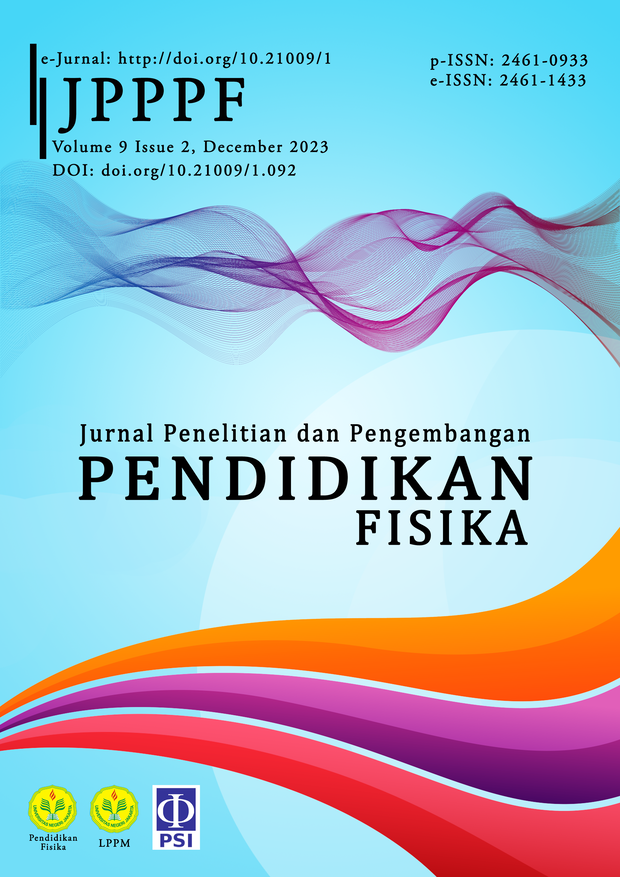Reasons for Students Interest in Learning Physics Subjects in Senior High School
DOI:
https://doi.org/10.21009/1.09208Keywords:
questionnaire, interesting way of teaching teachers, qualitative description, interest to learnAbstract
The purpose of this study was to identify the reasons of students' interest in learning physics in Senior High School. This type of research is descriptive qualitative. The data collection method used includes a questionnaire. The questionnaire is in the form of closed questions with a Likert scale from 1-5 addressed to students. This research was conducted in local schools in the city of Semarang that were selected in accordance with the direction and objectives of this research. School A represents superior schools, school B represents mediocre schools, and school C represents non-excellent schools.The results showed that 1) the highest percentage of interest in learning physics was at School A which was 78.72%. Meanwhile, the lowest percentage of interest in learning physics is 46.83% (School C). The percentages are 67.59%, 56.76%, and 55.56%, respectively.
References
Fatonah, U, Wirayuda, RP, Wibisono, G, Sakahuni, S 2020, ‘Analisis Minat Belajar Kelas XI SMA Negeri 1 Sungai Penuh Pada Pembelajaran Fisika’, Jurnal Sains dan Pendidikan Fisika (JSPF), vol. 16, no. 2, pp. 145-152.
Fong, CJ, Kremer, KP, Cox, CHT, Lawson, CA 2021, ‘Expectancy-value profiles in math and science: A person-centered approach to cross-domain motivation with academic and STEM-related outcomes’, Contemporary Educational Psychology, vol. 65, p. 101962.
Franzen, P, Katrin Arens, A, Greiffa, S, Niepel, C 2022, ‘Student profiles of self-concept and interest in four domains: A latent transition analysis’, Learning and Individual Differences, vol. 95, p. 102139.
Jiang, Y & Zhang, L 2023, ‘High school students' expectancy, value, and cost profiles and their relations with engagement and achievement in Math and English’, Learning and Individual Differences, vol. 101, p. 102252.
Laras, SA & Rifai, A 2019, ‘Pengaruh Minat Dan Motivasi Belajar Terhadap Hasil Belajar Peserta Didik Di BBPLK Semarang’, Jurnal Eksistensi Pendidikan Luar Sekolah (E-Plus), vol. 4, no. 2.
learning environments’, Contemporary Educational Psychology, vol. 70, p. 102082.
Mahyudi, S 2012, ‘Peranan Gaya Mengajar Guru Fisika Terhadap Minat Belajar Fisika Siswa Kelas IX MTs Istiqlal Delitua’, Jurnal Pendidikan Fisika, vol. 1, no. 1.
Nehru, N & Syarkowi, A 2017, ‘Analisis Desain Pembelajaran Untuk Meningkatkan Literasi Sains Berdasarkan Profil Penalaran Ilmiah’, WaPFi (Wahana Pendidikan Fisika), vol. 2, no. 1, pp. 20-24.
Pathoni, H, Pujaningsih, FB, Hendri, M, Maison, M & Nehru, N 2019, ‘Pelatihan Pengembangan Content E-Learning Untuk Guru IPA SE-JALUKO’, SELAPARANG Jurnal Pengabdian Masyarakat Berkemajuan, vol. 3, no. 1, pp. 120-123.
Ramadhan, SM & Haryadi, R 2022, ‘Karakteristik, Keterampilan, Kompetensi pembelajaran dan peran guru di abad 21’, Proceeding: Islamic, University of Kalimantan.
Ruf, A, Zahn, C, Agotai, D, Iten, G & Opwis, K 2022, ‘Aesthetic design of app interfaces and their impact on secondary students’interest and learning’, Computers and Education Open, vol. 3, p. 100075.
Schweder, S & Raufelder, D 2022, ‘Students’ interest and self-efficacy and the impact of changing
Simanjuntak, MDR 2019, ‘Membangun Ketrampilan 4 C Siswa Dalam Menghadapi Revolusi Industri 4.0’, pp. 921-929.
Sirait, ED 2016, ‘Pengaruh minat belajar terhadap prestasi Belajar Matematika’, Formatif: Jurnal Ilmiah Pendidikan MIPA, vol. 6, no. 1.
Slameto 2010, ‘Belajar dan Faktor-Faktor yang Mempengaruhinya’, Rineka Cipta, Jakarta.
Sudjana, N 1989, ‘Dasar - dasar Proses Belajar Mengajar’, Sinarbaru, Bandung.
Undang Undang Sistem Pendidikan Nasional 2003, ‘Rumusan tujuan pendidikan Nasional pada Undang-Undang Sistem Pendidikan Nasional’, no. 20.
Winkel 1996, ‘Psikologi Pengajaran’, Grasindo, Jakarta.
Yolviansyah, F, Suryanti, S, Setiya Rini, EF, Wahyuni, S & Matondang, MM 2021, ‘Hubungan Minat Belajar Siswa Terhadap Hasil Belajar Fisika Di SMA N 3 Muaro Jambi’, Tunjuk Ajar J. Penelitian Ilmu Pendidikan, vol. 4, no. 1, pp. 16-25.
Yuniani, A, Ardianty, DI & Rahmadani, WA 2019, ‘Era revolusi industri 4.0: peran media sosial dalam proses pembelajaran fisika di SMA’, GRAVITASI: Jurnal Pendidikan Fisika Dan Sains, vol. 2, no. 1, pp. 18-24.











